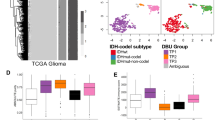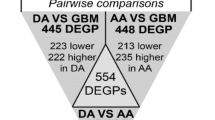Abstract
Background
Gliomas traditionally have been sub-classified based on histopathological observations. However, this approach is subject to inter-observer variability, and histopathological features may not reflect the biological mechanisms that drive tumor growth. High-throughput transcriptional profiling has shown promise in objectively and reproducibly identifying glioma subtypes. Most prior studies have typically used only modest sample sizes and have sometimes overlooked important data-processing steps to ensure sample quality and to evaluate the robustness of quantitative findings. The purpose of our study was to define robust glioma subtypes by applying rigorous preprocessing and validation steps to 1,952 microarray samples aggregated from 16 prior studies. This data set is the most comprehensive collection of glioma microarray samples compiled to date.
Methods and results
We evaluated each sample for quality-control issues, corrected for probe-composition biases, and adjusted for intra- and inter-study batch effects. Using a training/testing validation design that simulates a “bench-to-bedside process,” we identified six transcriptional subtypes that contained a heterogeneous mix of histopathological subtypes and tumor grades. Similar to prior studies, age, survival and treatment patterns differed significantly across the transcriptional subtypes. However, due to our large sample size, we also observed that within a given histopathological subtype, our transcriptional subtypes provided additional prognostic value. Lastly, we used a pathway-based approach to elucidate the biological mechanisms associated with each subtype.
Conclusions
Our findings provide clinical and biological insights that may not be apparent with alternative approaches or smaller data sets, and our approach serves as an example for meta-analyses that can be applied to other complex diseases.



Similar content being viewed by others
References
D.N. Louis, H. Ohgaki, O.D. Wiestler, W.K. Cavenee, P.C. Burger, A. Jouvet, B.W. Scheithauer, P. Kleihues, The 2007 WHO classification of tumours of the central nervous system. Acta Neuropathol. 114, 97–109 (2007)
H. Ohgaki, P. Kleihues, Population-based studies on incidence, survival rates, and genetic alterations in astrocytic and oligodendroglial gliomas. J. Neuropathol. Exp. Neurol. 64, 479–489 (2005)
D. Krex, B. Klink, C. Hartmann, A. von Deimling, T. Pietsch, M. Simon, M. Sabel, J.P. Steinbach, O. Heese, G. Reifenberger, Long-term survival with glioblastoma multiforme. Brain 130, 2596–2606 (2007)
L.A. Cooper, D.A. Gutman, Q. Long, B.A. Johnson, S.R. Cholleti, T. Kurc, J.H. Saltz, D.J. Brat, C.S. Moreno, The proneural molecular signature is enriched in oligodendrogliomas and predicts improved survival among diffuse gliomas. PLoS One 5, e12548 (2010)
S.R. Piccolo, L. Frey, Clinical and molecular models of Glioblastoma multiforme survival. Int. J.s Data Min. Bioinforma. 7, 245–265 (2013)
C.L. Nutt, D.R. Mani, R.A. Betensky, P. Tamayo, J.G. Cairncross, C. Ladd, U. Pohl, C. Hartmann, M.E. McLaughlin, T.T. Batchelor, P.M. Black, A. von Deimling, S.L. Pomeroy, T.R. Golub, D.N. Louis, Gene expression-based classification of malignant gliomas correlates better with survival than histological classification. Cancer Res. 63, 1602–1607 (2003)
P.J. Valk, R.G. Verhaak, M.A. Beijen, C.A. Erpelinck, B. van Waalwijk, S. van Doorn-Khosrovani, J.M. Boer, H.B. Beverloo, M.J. Moorhouse, P.J. van der Spek, B. Lowenberg, R. Delwel, Prognostically useful gene-expression profiles in acute myeloid leukemia. N. Engl. J. Med. 350, 1617–1628 (2004)
R.G. Verhaak, K.A. Hoadley, E. Purdom, V. Wang, Y. Qi, M.D. Wilkerson, C.R. Miller, L. Ding, T. Golub, J.P. Mesirov, Integrated genomic analysis identifies clinically relevant subtypes of glioblastoma characterized by abnormalities in PDGFRA, IDH1, EGFR, and NF1. Cancer Cell 17, 98–110 (2010)
W.A. Freije, F.E. Castro-Vargas, Z. Fang, S. Horvath, T. Cloughesy, L.M. Liau, P.S. Mischel, S.F. Nelson, Gene expression profiling of gliomas strongly predicts survival. Cancer Res. 64, 6503–6510 (2004)
G.N. Fuller, K.R. Hess, C.H. Rhee, W.K. Yung, R.A. Sawaya, J.M. Bruner, W. Zhang, Molecular classification of human diffuse gliomas by multidimensional scaling analysis of gene expression profiles parallels morphology-based classification, correlates with survival, and reveals clinically-relevant novel glioma subsets. Brain Pathol. 12, 108–116 (2002)
L.A. Gravendeel, M.C. Kouwenhoven, O. Gevaert, J.J. de Rooi, A.P. Stubbs, J.E. Duijm, A. Daemen, F.E. Bleeker, L.B. Bralten, N.K. Kloosterhof, B. De Moor, P.H. Eilers, P.J. van der Spek, J.M. Kros, P.A. Sillevis Smitt, M.J. van den Bent, P.J. French, Intrinsic gene expression profiles of gliomas are a better predictor of survival than histology. Cancer Res. 69, 9065–9072 (2009)
Y. Lee, A.C. Scheck, T.F. Cloughesy, A. Lai, J. Dong, H.K. Farooqi, L.M. Liau, S. Horvath, P.S. Mischel, S.F. Nelson, Gene expression analysis of glioblastomas identifies the major molecular basis for the prognostic benefit of younger age. BMC Med. Genomics 1, 52 (2008)
J. Margareto, O. Leis, E. Larrarte, M.A. Idoate, A. Carrasco, J.V. Lafuente, Gene expression profiling of human gliomas reveals differences between GBM and LGA related to energy metabolism and notch signaling pathways. J. Mol. Neurosci. 32, 53–63 (2007)
H.S. Phillips, S. Kharbanda, R. Chen, W.F. Forrest, R.H. Soriano, T.D. Wu, A. Misra, J.M. Nigro, H. Colman, L. Soroceanu, P.M. Williams, Z. Modrusan, B.G. Feuerstein, K. Aldape, Molecular subclasses of high-grade glioma predict prognosis, delineate a pattern of disease progression, and resemble stages in neurogenesis. Cancer Cell 9, 157–173 (2006)
T. Liu, T. Papagiannakopoulos, K. Puskar, S. Qi, F. Santiago, W. Clay, K. Lao, Y. Lee, S.F. Nelson, H.I. Kornblum, Detection of a microRNA signal in an in vivo expression set of mRNAs. PLoS One 2, e804 (2007)
L.P. Petalidis, A. Oulas, M. Backlund, M.T. Wayland, L. Liu, K. Plant, L. Happerfield, T.C. Freeman, P. Poirazi, V.P. Collins, Improved grading and survival prediction of human astrocytic brain tumors by artificial neural network analysis of gene expression microarray data. Mol. Cancer Ther. 7, 1013–1024 (2008)
J.N. Rich, C. Hans, B. Jones, E.S. Iversen, R.E. McLendon, B. Rasheed, A. Dobra, H.K. Dressman, D.D. Bigner, J.R. Nevins, Gene expression profiling and genetic markers in glioblastoma survival. Cancer Res. 65, 4051 (2005)
Ducray F, De Reynies A, Chinot O, Idbaih A, Figarella-Branger D, Colin C, Karayan-Tapon L, Chneiweiss H, Wager M, Vallette F. An ANOCEF genomic and transcriptomic microarray study of the response to radiotherapy or to alkylating first-line chemotherapy in glioblastoma patients. Molecular cancer 9 (2010)
A. Murat, E. Migliavacca, T. Gorlia, W.L. Lambiv, T. Shay, M.F. Hamou, N. De Tribolet, L. Regli, W. Wick, M. Kouwenhoven, Stem cell–related “self-renewal” signature and high epidermal growth factor receptor expression associated with resistance to concomitant chemoradiotherapy in glioblastoma. J. Clin. Oncol. 26, 3015 (2008)
S. Madhavan, J.C. Zenklusen, Y. Kotliarov, H. Sahni, H.A. Fine, K. Buetow, Rembrandt: helping personalized medicine become a reality through integrative translational research. Mol. Cancer Res. 7, 157–167 (2009)
J.L. Garcia, J. Couceiro, J.A. Gomez-Moreta, J.G. Valero, A.S. Briz, V. Sauzeau, E. Lumbreras, M. Delgado, C. Robledo, M.L. Almunia, Expression of VAV1 in the tumour microenvironment of glioblastoma multiforme. J. Neuro-Oncol. 110, 69–77 (2012)
T.J. Hudson, W. Anderson, A. Aretz, A.D. Barker, C. Bell, R.R. Bernabé, M. Bhan, F. Calvo, I. Eerola, D.S. Gerhard, International network of cancer genome projects. Nature 464, 993–998 (2010)
C.W. Brennan, R.G. Verhaak, A. McKenna, B. Campos, H. Noushmehr, S.R. Salama, S. Zheng, D. Chakravarty, J.Z. Sanborn, S.H. Berman, The somatic genomic landscape of glioblastoma. Cell 155, 462–477 (2013)
Liu Z, Yao Z, Li C, Lu Y, Gao C (2011) Gene expression profiling in human high-grade astrocytomas. Comparative and functional genomics 2011
J. Zhou, T. Xu, Y. Yan, R. Qin, H. Wang, X. Zhang, Y. Huang, Y. Wang, Y. Lu, D. Fu, MicroRNA-326 functions as a tumor suppressor in glioma by targeting the nin one binding protein (NOB1). PLoS One 8, e68469 (2013)
Kaufman L, Rousseeuw PJ. Clustering Large Applications (Program CLARA). Finding groups in data: an introduction to cluster analysis: 126–163 (1990)
J. Handl, J. Knowles, D.B. Kell, Computational cluster validation in post-genomic data analysis. Bioinformatics 21, 3201 (2005)
W.E. Johnson, C. Li, A. Rabinovic, Adjusting batch effects in microarray expression data using empirical Bayes methods. Biostatistics 8, 118–127 (2007)
Piccolo SR, Sun Y, Campbell JD, Lenburg ME, Bild AH, Johnson WE. A single-sample microarray normalization method to facilitate personalized-medicine workflows. Genomics. (2012)
E. Freyhult, M. Landfors, J. Onskog, T.R. Hvidsten, P. Ryden, Challenges in microarray class discovery: a comprehensive examination of normalization, gene selection and clustering. BMC Bioinforma. 11, 503 (2010)
Poonam P, Dutta M. Performance Analysis of Clustering Methods for Outlier Detection; 2012. IEEE. pp. 89–95
M. Vitucci, D.N. Hayes, C.R. Miller, Gene expression profiling of gliomas: merging genomic and histopathological classification for personalised therapy. Br. J. Cancer 104, 545–553 (2011)
Eijssen LM, Jaillard M, Adriaens ME, Gaj S, de Groot PJ, Müller M, Evelo CT. User-friendly solutions for microarray quality control and pre-processing on ArrayAnalysis. org. Nucleic acids research. (2013)
M. Dai, P. Wang, A.D. Boyd, G. Kostov, B. Athey, E.G. Jones, W.E. Bunney, R.M. Myers, T.P. Speed, H. Akil, Evolving gene/transcript definitions significantly alter the interpretation of GeneChip data. Nucleic Acids Res. 33, e175 (2005)
Brock G, Pihur V, Datta S, Datta S (2011) clValid, an R package for cluster validation. Journal of Statistical Software (Brock et al., March 2008).
K.Y. Yeung, W.L. Ruzzo, Principal component analysis for clustering gene expression data. Bioinformatics 17, 763–774 (2001)
E.L. Kaplan, P. Meier, Nonparametric estimation from incomplete observations. J. Am. Stat. Assoc. 53, 457–481 (1958)
Cox DR. Regression models and life-tables. Journal of the Royal Statistical Society Series B (Methodological): 187–220 (1972)
Team RC (2013) R: A Language and Environment for Statistical Computing. R Foundation for Statistical Computing, Vienna, Austria. URL http://www.R-project.org/
A. Subramanian, P. Tamayo, V.K. Mootha, S. Mukherjee, B.L. Ebert, M.A. Gillette, A. Paulovich, S.L. Pomeroy, T.R. Golub, E.S. Lander, J.P. Mesirov, Gene set enrichment analysis: a knowledge-based approach for interpreting genome-wide expression profiles. Proc. Natl. Acad. Sci. U. S. A. 102, 15545–15550 (2005)
R. McLendon, A. Friedman, D. Bigner, E.G. Van Meir, D.J. Brat, G.M. Mastrogianakis, J.J. Olson, T. Mikkelsen, N. Lehman, K. Aldape, Comprehensive genomic characterization defines human glioblastoma genes and core pathways. Nature 455, 1061–1068 (2008)
W.-Y. Cheng, J.J. Kandel, D.J. Yamashiro, P. Canoll, D. Anastassiou, A multi-cancer mesenchymal transition gene expression signature is associated with prolonged time to recurrence in glioblastoma. PLoS One 7, e34705 (2012)
V.G. Tusher, R. Tibshirani, G. Chu, Significance analysis of microarrays applied to the ionizing radiation response. Proc. Natl. Acad. Sci. 98, 5116–5121 (2001)
M. Nozaki, M. Tada, H. Kobayashi, C.-L. Zhang, Y. Sawamura, H. Abe, N. Ishii, E.G. Van Meir, Roles of the functional loss of p53 and other genes in astrocytoma tumorigenesis and progression. Neuro-Oncology 1, 124–137 (1999)
L. Shi, R.G. Perkins, H. Fang, W. Tong, Reproducible and reliable microarray results through quality control: good laboratory proficiency and appropriate data analysis practices are essential. Curr. Opin. Biotechnol. 19, 10–18 (2008)
L. Shi, G. Campbell, W.D. Jones, F. Campagne, Z. Wen, S.J. Walker, Z. Su, T.-M. Chu, F.M. Goodsaid, L. Pusztai, The microarray quality control (MAQC)-II study of common practices for the development and validation of microarray-based predictive models. Nat. Biotechnol. 28, 827–838 (2010)
H. Ohgaki, P. Kleihues, The definition of primary and secondary glioblastoma. Clin. Cancer Res. 19, 764–772 (2013)
Acknowledgments
We thank the patients who donated biospecimens for the various microarray studies we evaluated. We acknowledge an allocation of computer time from the Center for High Performance Computing at the University of Utah.
Author contributions
SL, SRP, and KAB conceived the study design and computational approach. SL and SRP performed all computational and statistical analyses. SL, SRP and KAB interpreted the analysis results and wrote the manuscript.
Conflict of interest
The authors declare no conflict of interest.
Funding sources
SRP was funded in part by NIH Grant 5T32CA093247. The authors declare no other funding sources that specifically supported this research.
Author information
Authors and Affiliations
Corresponding author
Rights and permissions
About this article
Cite this article
Lee, S., Piccolo, S.R. & Allen-Brady, K. Robust meta-analysis shows that glioma transcriptional subtyping complements traditional approaches. Cell Oncol. 37, 317–329 (2014). https://doi.org/10.1007/s13402-014-0190-8
Accepted:
Published:
Issue Date:
DOI: https://doi.org/10.1007/s13402-014-0190-8




